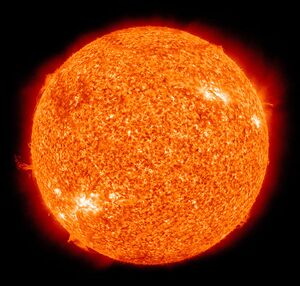
Solar energy means energy from sunlight, in any form. Solar energy, radiant light and heat from the sun, has been harnessed by humans since ancient times using a range of ever-evolving technologies. Solar radiation, along with secondary solar-powered resources such as wind and wave power, hydroelectricity and biomass, account for most of the available renewable energy on earth. Only a minuscule fraction of the available solar energy is used. Solar energy's uses are limited by human ingenuity, and the finite resourced to build the sys.
A partial list of solar applications includes space heating and cooling through solar architecture, potable water via distillation and disinfection, daylighting, solar hot water, solar cooking, and high temperature process heat for industrial purposes. To harvest the solar energy, the most common way is to use solar panels.
Solar technologies are characterized as either passive solar or active solar, depending on the way the energy is captured, converted and distributed. Active solar techniques include the use of photovoltaic panels and solar thermal collectors to harness the energy. Passive solar techniques include orienting a building to the suns seasonal orientation, selecting materials with favorable thermal mass, which will capture and radiate solar energy, light dispersing properties that will disperse light energy, or designing spaces that naturally circulate solar heated air.
Solar paneled roofs and devices are all around us. Their presence in society increased in conjunction with environmental consciousness. Solar power is a renewable alternative to the greenhouse gas-emitting fossil fuels affecting the atmosphere and the climate.
Nonrenewable energy sources, like oil, natural gas, and coal, pollute the environment and trap heat in the upper layers of Earth’s atmosphere. As heat remains in the atmosphere for an extended period, the global temperature rises. This increase impacts consistent weather patterns across the planet, otherwise known as climate change.
To challenge these adverse effects on the environment, renewable energy stepped up to the plate. Solar power is now the most popular form of renewable energy. To better understand how these systems can reduce the effects of climate change, we must first evaluate its roots.[1]
Applications[edit | edit source]

Some forms of solar energy such as heating are well-adapted to low-technology appropriate construction, while others such as photovoltaic cells for the production of electricity are typically mass-produced in high-tech capital-intensive factories. Designs can be active or passive [expansion needed]
Electricity[edit | edit source]
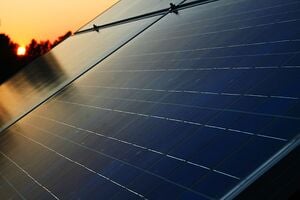
Solar power is the conversion of energy from sunlight into electricity. It can be done directly using photovoltaics (PV), indirectly using concentrated solar power, or a combination. Photovoltaic cells convert light into an electric current using the photovoltaic effect. Concentrated solar power systems use lenses or mirrors and solar tracking systems to focus and concentrate a large area of sunlight to a small beam or point.
It is generally considered to be "Green", renewable, sustainable, and environmentally friendly. With an increasing cost of energy and alternative energies, solar power is becoming more economically feasible and important in many areas such as solar lighting.
Cooking[edit | edit source]
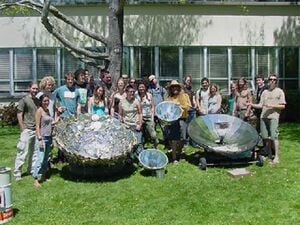
Several engineers and DIY enthusiasts have designed literally hundreds of different types of solar cookers; from simple designs like the solar bowling oven to more complicate ones like the parabolic basket and tin can solar cooker. This expansive variety of options makes it difficult to standardize and evaluate solar cookers, however some critical factors must be met for a design to be successful, some of which are listed below: Cost - must be cheap enough to be viable for implementation into rural areas.
- Convenience - can be built by readily available local materials in a short period of time, as well as being light-weight.SOL
- Safety - heated area must be well protected and no parts should be jutting out.
- Efficiency - how long will it take to cook the food?
- Wind resistance - must be sturdy enough to not be affected by light to moderate winds.
- Heating capacity - sufficient heating capacity based on it's use (water pasteurization vs. cooking food).
- Durability - repairs should be infrequent and easily performed.
- Simplicity of instructions.
The requirements for solar cooking are very simple. You must be able to place the solar cooker in a location that gets sun for several hours and be protected from strong wind. Solar cookers, obviously do not work at night or on very cloudy days. The sunlight is absorbed on dark surfaces that heat up. Food cooks best in dark, shallow, thin metal pots with dark, tight-fitting lids to hold in heat and moisture. To retain the heat created when the black pot absorbs the suns rays some form of transparent cover is needed. This can be as simple as a clear plastic bag or as complicated as evacuated multiple layers of glass. One method to speed the cooking process is to use reflectors to increase the concentration of sunlight on your collector.
Dehydrating[edit | edit source]
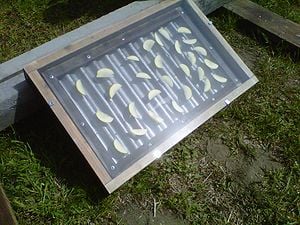
A solar dehydrator (or solar drier) allows the user to preserve food without the energy cost or pollution associated with other drying techniques.
Agricultural and other products have been dried by the sun and wind in the open air for thousands of years. The purpose is either to preserve them for later use, as is the case with food; or as an integral part of the production process, as with timber, tobacco and laundering. In industrialised regions and sectors, open air-drying has now been largely replaced by mechanised dryers, with boilers to heat incoming air, and fans to force it through at a high rate. Mechanised drying is faster than open-air drying, uses much less land and usually gives a better quality product. But the equipment is expensive and requires substantial quantities of fuel or electricity to operate.
'Solar drying' in the context of this technical brief, refers to methods of using the sun's energy for drying, but excludes open air 'sun drying'. The justification for solar dryers is that they may be more effective than sun drying, but have lower operating costs than mechanised dryers. A number of designs are proven technically and while none are yet in widespread use, there is still optimism about their potential.
Hot water[edit | edit source]
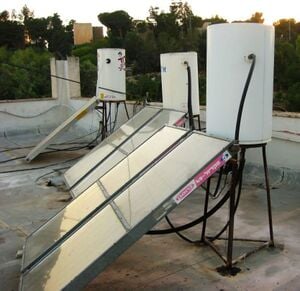
Solar hot water describes active and passive solar technologies that utilize the freely abundant solar thermal energy in order to heat water for a desired application.
It is one of the most efficient ways to heat water (in terms of energy/waste), as it requires no energy conversion, unlike electric-resistance heating or fuel burning. It is a simple transfer and concentration of heat energy from one place to another. (See Wikipedia:Heat transfer.) Another example of this technology's efficiency is it runs on solar energy, which is free, and only dependent on the technology used, and its cost and efficiency. In other words, the energy is free, only the collection, conversion, and storage devices contribute to the cost of the system. That being said, the main disadvantage of solar thermal energy is that it is only available wherever/whenever the Sun is visible.
If you have ever felt hot water trickle out of a garden hose that has been sitting in the sun, you’ve experienced solar hot water in action.
Essentially, a solar hot water system is made up of a solar thermal collector, a well-insulated storage container, and a system for transferring the heat from the collector to the container vis-à-vis a fluid medium, which in some cases is the water itself.
Water disinfection[edit | edit source]
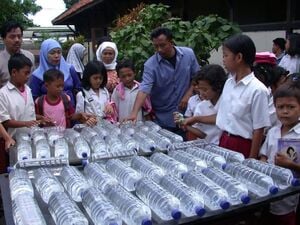
Solar water disinfection, also known as solar water pasteurisation or SODIS, is a method of disinfecting drinking water using the heat and UV light (or sometimes just heat) of the sun. The water must be already clear, especially when using the sun's UV light. Unlike solar distillation, it is a very simple and Low cost way of disinfecting small volumes of water.
Radiation in the spectrum of UV-A (wavelength 320-400nm) and increased water temperature, both factors cause damage to the DNA of the Pathogens. The effects are also synergistic - the DNA being more prone to UV damage if the temperature is very high. If the water temperatures raises above 50°C, the disinfection process is three times faster, and much better results are obtained from the UV. Certain pathogens such as Giardia,W however, are not easily killed by UV. For these, the heat is more important.[verification needed]
Distillation[edit | edit source]
Water distillation[edit | edit source]
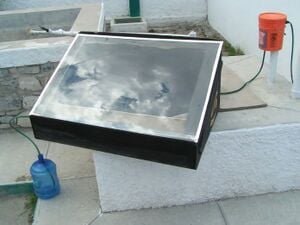
Solar distillation is the use of solar energy to evaporate water and collect its condensate within the same closed system. Unlike other forms of water purification it can turn salt or brackish water into fresh drinking water (e.g. desalination).
The structure that houses the process is known as a solar still and although the size, dimensions, materials, and configuration are varied, all rely on the simple procedure wherein an influent solution enters the system and the more volatile solvents leave in the effluent leaving behind the salty solute behind.[2]
In any solar still, the basic layout is a collection device to capture rainwater. In most cases the collector is covered by a sheet of glass or transparent plastic, which allows solar radiation to pass through but not to escape. Water evaporated by the radiant solar heat then condenses on the cooler cover material. The condensed water is free from impurities, such as salts and heavy metals, as well as microbiological organisms, that might have been present in the intake water. The end result is a supply of fresh, clean water. Solar stills can efficiently produce drinking water from ditch water or cistern water, especially high-efficiency multiple effect humidification designs, which separate the evaporator(s) and condenser(s).
Solar distillation differs from other forms of desalination that are more energy-intensive, such as reverse osmosis or simply boiling water, due to its use of free energy.[3][4] If treatment of polluted water is required rather than desalination, slow sand filtration is a good option.
Fuel alcohol distillation[edit | edit source]

An abundance of clean, locally-produced, combustible fuel could dramatically improve the standard of living in parts of the developing world. This fuel could transport goods to markets, produce steam and electricity, heat homes, boil water and cook food, provide power for communication equipment and provide for better standards of education and health. With less reliance on dirtier fuels, there would be less air pollution indoors and out, less deforestation and erosion of soils. This report describes the simple engineering required to increase the efficiency of a solar still to produce low-cost, concentrated ethanol for fuel at the local, "micro" level, reliably and safely.
Other uses[edit | edit source]
- Various steps in papermaking
- Producing mechanical energy with a heat engine
Measurement[edit | edit source]
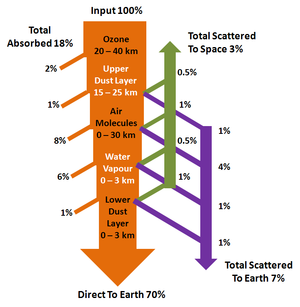
Solar energy is one of the most important sources of energy on earth, available to us in a number of derivatives. Plant matter for example, which relies on solar energy for nutrition, experiences natural compression and decomposition over millions of years to form the the fossil fuels we use today for electrical generation and transportation. Other examples of this can be seen in use of biomass for fuel or the harvesting of wind energy which is reliant on solar heated air for the formation of currents.
We are also able to utilize the solar resource directly. Solar thermal technologies take advantage of this resource to heat a working fluid that can transfer energy to an air stream or water for domestic or commercial use. Solar Photovoltaic or PV devices exploit various materials (principally Silicon) that experience sub-atomic variations when exposed to solar energy in order to induce an electric current. Both solar PV and thermal technologies provide a useful source of energy with little to no moving parts, no pollution and very little embodied energy.
In order to effectively design a solar energy system, an understanding of the available solar resource at the location of interest is required. This article aims to provide readers with an understanding of the earth's solar resource and introduces the tools required to perform a basic analysis. A brief overview of solar radiation measurement techniques and performance modeling will also be provided.
Conversion system[edit | edit source]
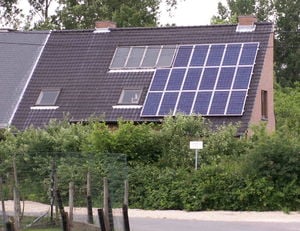
A solar energy conversion system (SECS),[5][6][7] or solar energy harvester are general terms that could be used for any machine that, powered by solar energy, either generates energy that can be used to directly heat a fluid or gas (passive solar) or generate electricity (PV, CPV, PETE,...). The term can thus refer to:
- Thermal solar energy conversion systems (generally passive solar systems without mirrors or lenses),
- Photovoltaic solar systems (PV),
- Biohybrid solar cells,
- Dye-sensitized solar cells,
- Luminescent solar concentrators (a type of concentrated photovoltaics or CPV technology),
- Concentrating solar power systems,
- Photon Enhanced Thermionic Emission systems,...[8]
Benefits[edit | edit source]
The solar energy benefits are multiple:
- Solar energy is one of the primary renewable energy sources
- A solar system can substantially reduce electricity bills. The amount that can be reduced from your bills depends on the size of the solar system and the household energy usage.
- Solar energy can be used for different purposes, such as electricity (photovoltaics) and heat (solar thermal).
- Solar energy systems generally require low maintenance costs. Cleaning companies ask on average for £25-£35 per cleaning, and manufacturers offer 20-25 years warranty.
- The technological developments taking place within the solar panel industry assure that solar panels will continue being one of the most effective sustainable energy sources on the planet.
For more specific articles on solar energy, see Category:Solar. or you can check out this website. Ethraa-a
The Sun[edit | edit source]
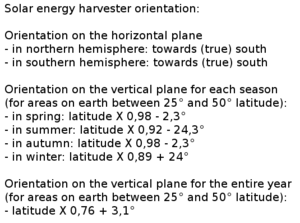

Our sun is one of the major sources of energy we have access to. The sun at its core converts hydrogen to helium through a thermonuclear fusion reaction. The energy from the reaction travels from the core of the sun to the surface and is primarily released as light. The energy the earth receives comes in two forms, heat and light. According to the US Department of Energy every hour enough energy reaches the earth to meet our energy demands for the whole year. The amount of sun that reaches the earth annually is 4x1018 Joules. The amount of energy consumed by world population is about 3X1015 Joules.
External links[edit | edit source]
GreenMatch - Pros and Cons of Solar Energy. The article containing information and graphics on benefits and disadvantages with buying solar energy systems.
See also[edit | edit source]
- Smart windows
- Sun related calculations
- Peer to peer finance mechanisms to support renewable energy growth
Notes and references[edit | edit source]
- ↑ A History of Solar Power - Green Living Consultants, Companies, Electric Car Expert, Green Living, Electric Car News https://greenlivingguy.com/2021/03/a-history-of-solar-power/
- ↑ (2008). Desalination, a national perspective. National Research Council of the National Academies.
- ↑ Abu-Arabi, M. (2007). Status and prospects for solar desalination in the MENA region. Solar Desalination for the 21 st Century, 163-178.
- ↑ Paton, C., & Davies, P. (2006). The seawater greenhouse cooling, fresh water and fresh produce from seawater. In The 2nd International Conference on Water Resources in Arid Environments, Riyadh.
- ↑ Solar energy conversion system term 1
- ↑ Solar energy conversion system term 2
- ↑ Solar energy conversion system
- ↑ Stanford PETE